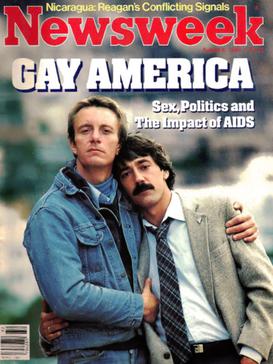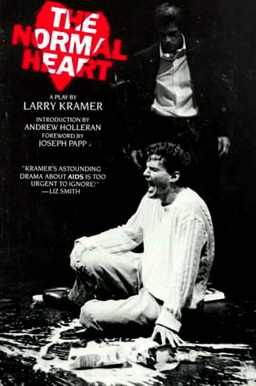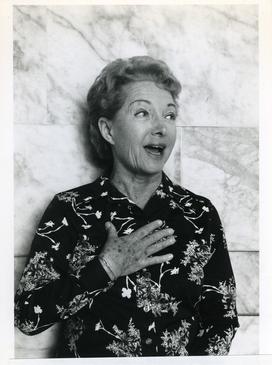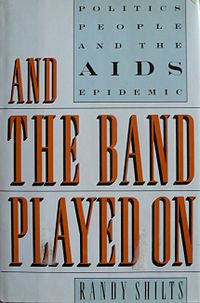Related Research Articles

The AIDS epidemic, caused by HIV, found its way to the United States between the 1970s and 1980s, but was first noticed after doctors discovered clusters of Kaposi's sarcoma and pneumocystis pneumonia in homosexual men in Los Angeles, New York City, and San Francisco in 1981. Treatment of HIV/AIDS is primarily via the use of multiple antiretroviral drugs, and education programs to help people avoid infection.

Gaëtan Dugas was a Canadian flight attendant whose role in the early years of the AIDS epidemic attracted considerable attention. Initially identified as a central figure labeled "Patient Zero", Dugas faced allegations of being a primary source of HIV transmission to the United States. This narrative, popularized notably by Randy Shilts' 1987 book And the Band Played On, has been refuted through subsequent scientific scrutiny and historical re-evaluation. Dugas' story highlights the perils of misinformation and the stigma surrounding HIV/AIDS in the 1980s. Despite facing criticism in popular discourse, subsequent studies have provided a more nuanced understanding of Dugas' impact on the epidemic, emphasizing the importance of accuracy and empathy in public health narratives.
Peter Adair was a filmmaker and artist, best known for his pioneering gay and lesbian documentary Word Is Out: Stories of Some of Our Lives (1977).

Robert Boyle "Bobbi" Campbell Jr. was a public health nurse and an early United States AIDS activist. In September 1981, Campbell became the 16th person in San Francisco to be diagnosed with Kaposi's sarcoma, when that was a proxy for an AIDS diagnosis. He was the first to come out publicly as a person with what came to be known as AIDS, writing a regular column in the San Francisco Sentinel, syndicated nationwide, describing his experiences and posting photos of his KS lesions to help other San Franciscans know what to look for, as well as helping write the first San Francisco safer sex manual.

The Normal Heart is a largely autobiographical play by Larry Kramer. It focuses on the rise of the HIV/AIDS epidemic in New York City between 1981 and 1984, as seen through the eyes of writer/activist Ned Weeks, the gay founder of a prominent HIV advocacy group. The play's title comes from W. H. Auden's poem, "September 1, 1939".
Theatre Rhinoceros, Theatre Rhino, or The Rhino is a gay and lesbian theatre in San Francisco. Theatre Rhinoceros claims to be the world's longest-running professional queer theatre company. It was founded in the spring of 1977 by Lanny Baugniet and his late partner Allan B. Estes, Jr.. The name is based on the lavender rhinoceros, a symbol popularized by the Boston gay community in the mid-1970s. It is a non-profit theater company dedicated to the production of plays by and about gay and lesbian people.

Common Threads: Stories from the Quilt is a 1989 American documentary film that tells the story of the NAMES Project AIDS Memorial Quilt. Narrated by Dustin Hoffman, with a musical score written and performed by Bobby McFerrin, the film focuses on several people who are represented by panels in the Quilt, combining personal reminiscences with archive footage of the subjects, along with footage of various politicians, health professionals and other people with AIDS. Each section of the film is punctuated with statistics detailing the number of Americans diagnosed with and dead from AIDS through the early years of the epidemic. The film ends with the first display of the complete Quilt at the National Mall in Washington, D.C., during the 1987 Second National March on Washington for Lesbian and Gay Rights.

As Is is a 1985 American play written by William M. Hoffman. The play was first produced by Circle Repertory Company and The Glines and directed by Marshall W. Mason. It opened on March 10, 1985 at the Circle Rep in New York City, where it ran for 49 performances.

And the Band Played On is a 1993 American television film docudrama directed by Roger Spottiswoode. The teleplay by Arnold Schulman is based on the best-selling 1987 non-fiction book And the Band Played On: Politics, People, and the AIDS Epidemic by Randy Shilts, and is noteworthy for featuring both a vast historical scope, as well as an exceptionally sprawling cast.

Selma Kaderman Dritz was an American physician and epidemiologist who worked in San Francisco, California, where she began tracking the first known cases of Acquired Immune Deficiency Syndrome (AIDS) in the early 1980s.

And the Band Played On: Politics, People, and the AIDS Epidemic is a 1987 book by San Francisco Chronicle journalist Randy Shilts. The book chronicles the discovery and spread of the human immunodeficiency virus (HIV) and acquired immune deficiency syndrome (AIDS) with a special emphasis on government indifference and political infighting—specifically in the United States—to what was then perceived as a specifically gay disease. Shilts's premise is that AIDS was allowed to happen: while the disease is caused by a biological agent, incompetence and apathy toward those initially affected allowed its spread to become much worse.

How to Have Sex in an Epidemic: One Approach is a 1983 manual by Richard Berkowitz and Michael Callen, under the direction of Joseph Sonnabend, to advise men who have sex with men (MSM) about how to avoid contracting the infecting agent which causes AIDS. It was among the first publications to recommend the use of condoms to prevent the transmission of STDs in men having sex with men, and has even been named, along with Play Fair!, as one of the foundational publications in the advent of modern safe sex.

Walt Whitman Odets is an American clinical psychologist and author. He has written about the early development, psychological and social experiences of gay men and their communities. Odets' earlier writing focused on the lives of men living in and surviving the early AIDS epidemic. The spring 1996 issue of Positive Impact Journal called him "an important voice in the AIDS education and prevention arena." Odets's 1995 study, In the Shadow of the Epidemic: Being HIV-Negative in the Age of AIDS, was listed by The New York Times as among the "Notable Books of the Year 1995." Additionally, In the Shadow of the Epidemic was the No. 1 bestselling book purchased by gay men in the late fall of 1995, according to The Advocate, and was confirmed as a "Gay Bestseller of 1995" by the Feminist Bookstore News.

The San Francisco AIDS Foundation (SFAF) is a nonprofit organization dedicated to providing services for people with HIV/AIDS, with a mission to end the AIDS epidemic in the United States. They were founded in 1982, at the beginning of the AIDS epidemic. SFAF is one of the largest and oldest community-based AIDS service organizations in the United States. SFAF has an 87.67% overall rating, and a 97% accountability & transparency rating, at Charity Navigator.
Reggie Williams was an American AIDS activist, who fought for culturally relevant AIDS education and services for gay and bisexual men of color. Williams served as a board member for the National Association of Black and White Men Together and as the first executive director of the National Task Force on AIDS Prevention.
New York City was affected by the AIDS epidemic of the 1980s more than any other U.S. city. The AIDS epidemic has been and continues to be highly localized due to a number of complex socio-cultural factors that affect the interaction of the populous communities that inhabit New York.
Henry M. Tavera was an AIDS activist, artistic director, and archivist based in the Mission District of San Francisco, California; his 1979 move to the region put him at the forefront of the AIDS epidemic via his involvement in various HIV/AIDS service organizations as well as AIDS theatre. He also did work around Chicano Gay Activism and teaching/advising. Tavera died on February 27, 2000, at 56 years old from kidney cancer.

Leland Moss was an American theatre director, writer, and gay activist who died from AIDS at age 41.

Socio-political activism to raise awareness about HIV/AIDS as well as to advance the effective treatment and care of people with AIDS (PWAs) has taken place in multiple locations since the 1980s. The evolution of the disease's progress into what's known as the HIV/AIDS pandemic has resulted in various social movements fighting to change both government policies and the broader popular culture inside of different areas. These groups have interacted in a complex fashion with others engaged in related forms of social justice campaigning, with this continuing on to this day.
The AIDS–Holocaust metaphor is used by AIDS activists to compare the AIDS epidemic to the Holocaust. The comparison was popularized by Larry Kramer and ACT-UP, especially the organization's French chapter, as a way to garner sympathy for AIDS sufferers and spur research into the disease. Although the comparison is now "commonly heard" with regard to AIDS, critics maintain that it is a form of Holocaust trivialization.